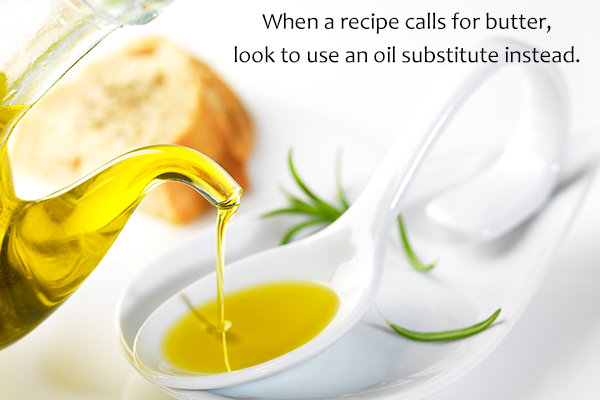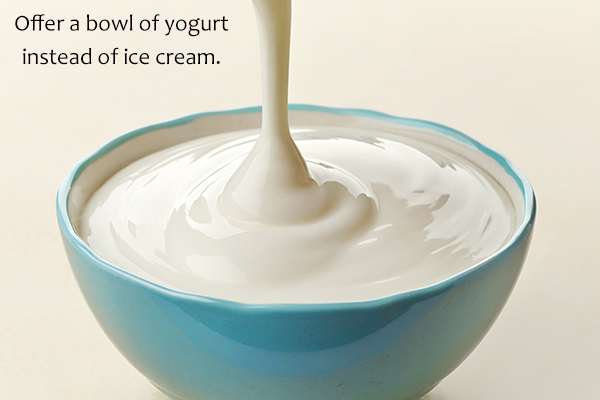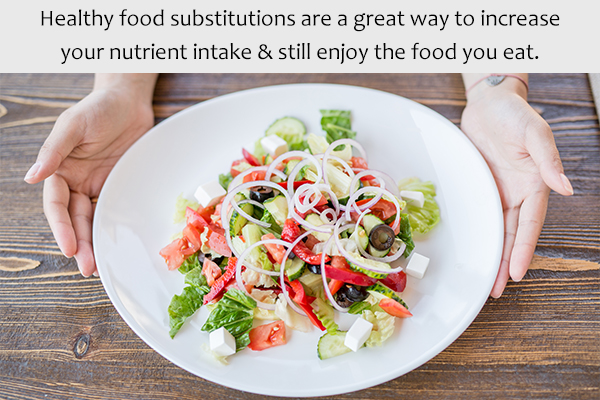In this article:
A healthy diet is not only vital for losing or maintaining body weight, but it also helps decrease cholesterol levels in the body while preventing other health conditions. Therefore, it is important to be conscious of the foods and drinks you consume.

Building a healthy diet can be as simple as finding food substitutions for foods high in fat, sodium, and sugar. This will help you make better choices when cooking at home or eating out at restaurants.
Make Your Meals More Nutritious
Healthy eating can be as easy as swapping ingredients in a recipe. When cooking nutritious meals, understanding the kinds of nutrients in the foods you are preparing is important to achieve a healthy diet.
Nutrients such as saturated fat, trans fat, salt, and sugar should be limited in your diet. (1) Look to increase foods that contain fiber, protein, vitamins, and minerals.
Healthy Alternatives for Common Baking Ingredients
Baked goods, such as cakes, cookies, and muffins, are typically high in fat and sugar. There are easy ways to substitute the fat and sugar with healthy alternatives and still maintain the delicious taste.
Butter is a common ingredient that adds a savory and flaky texture to baked goods. However, butter is full of saturated fats that raise LDL cholesterol levels in the body, increasing the risk of cardiovascular disease. (2)
Some alternatives for butter when baking quick breads, cookies, cakes, brownies, and muffins include:
Sugar not only adds sweetness but also keeps baked goods soft and traps water, keeping it moist. However, added sugars, such as granulated sugar, is linked to obesity, type 2 diabetes, and cardiovascular disease. (3)
It is important that less than 10% of your calories each day come from added sugars. (4)
Some alternatives for sugar when baking include:
- Applesauce
- Honey
- Molasses
- Agave nectar
Healthy Butter Substitutes for Daily Cooking

When a recipe calls for butter, look to use an oil substitute instead. Butter and lard contain high levels of saturated fat that increase your risk of cardiovascular disease. (2)
Oils are unsaturated (monounsaturated and polyunsaturated) fats found as a liquid at room temperature and are of two types:
- Monounsaturated fats, including olive, canola, peanut, sunflower, and coconut oils. They are key players in the Mediterranean diet and have shown to reduce cardiovascular risk. (5)
- Polyunsaturated fats, including safflower, corn, soybean, cottonseed, sunflower, and palm kernel oils. They contain essential fatty acids called omega-3 and omega-6 fatty acids. The body does not make these two classes of fatty acids and must be consumed from the diet.
Some oils such as coconut oil or palm and palm kernel oils contain higher levels of saturated fat and should be consumed less often.
Spices to Use Instead of Salt
Salt (or sodium) is commonly added to dishes for flavor and is used as a preservative in processed foods.
According to the Dietary Guidelines, it is recommended that Americans reduce their salt intake to less than 2,300 mg per day for adults and children. High intake of salt can be linked to high blood pressure and cardiovascular disease risk in adults. (6)
Many spices and fresh herbs are great alternatives for salt. These include:
- Pepper and pepper flakes
- Mrs. Dash
- Garlic powder
- Onion powder
- Chili powder
- Paprika
- Basil
- Rosemary
- Cilantro
- Oregano
Smart Snacking

Snacks are a great way to give your body a boost of healthful nutrients in between meals. Snacks are recommended as part of a healthy diet because they refuel the body with lost nutrients.
What’s important is that the snacks you are eating are nutrient-dense and not high in calories. (7)
It is easy to want to go for salty or sweet snacks for a quick pick-me-up. Making simple healthy swaps can help increase your nutrients and still satisfy your cravings.
- Instead of eating candy, try a handful of trail mix containing mixed nuts and seeds.
- Try a smoothie instead of ice cream. Smoothies can contain a variety of fruits or vegetables that offer lots of vitamins and minerals while still satisfying that sweet tooth.
- Eat whole-wheat crackers with nut butter instead of a cookie for a high-protein and high-fiber snack.
- Substitute potato chips with carrots and hummus. A tasty dip like hummus is full of protein and nutrients. Pair it with carrots, and you will get a nice crunch similar to that of chips.
- Craving soda? Try seltzer instead. Seltzer water offers the same carbonation as soda drinks that will make you feel refreshed without the added sugars.
ALSO READ: 25 Healthy Snacks with Only Around 100 Calories
What Are Some Substitutes for Fresh Produce?
Fresh vegetables and fruits are essential to a healthy diet. However, fresh produce is not the only way to get plentiful nutrients such as fiber, vitamins, and minerals.
Canned or frozen fruits and vegetables are great alternatives to fresh produce. They have a longer shelf-life, and they cost less. Although the fruit or vegetables may be canned or frozen, they do not lose their nutrient composition.
Try These Healthy Meal Options When Dining Out
Eating out at sit-down and fast-food restaurants is a convenience for a quick, tasty meal. However, most meals at restaurants are typically high in calories, fat, and salt.
Here are a few healthy tips when ordering out:
- Substitute a side of French fries with a roasted vegetable or side salad.
- Substitute a soda or sugary sweetened beverage with water or low-fat milk.
- Substitute a starter or appetizer plate for a main entree dish. Ordering a starter plate as your main meal will reduce your portion size and will still be filling.
Healthy Food Substitutions for Children

Children are notorious for being picky eaters. This may be difficult for parents to introduce healthy foods such as fruits or vegetables, which may not be appealing to younger children at first glance.
- Offer a bowl of yogurt instead of ice cream. What makes ice cream delicious is the creamy, rich flavor and sweetness. Try a low-fat yogurt instead and add granola or fruit to top it off.
- Add broccoli or cauliflower to macaroni and cheese. Adding a vegetable to a favorite dish is a great way to increase your child’s nutrients.
- Eat popcorn instead of potato chips. Popcorn is high in fiber, and low in fat compared to potato chips and still satisfies a savory craving.
- Make a veggie pizza instead of a plain cheese pizza. Adding colorful vegetables to your pizza night will offer lots of nutrients. Try making the pizza from scratch with help from your little ones.
Healthier Options to Replace Some Commonly Consumed Foods
While there are various swaps you can make, here are a few easy choices:
- Substitute whole-wheat pasta for white pasta. Whole-wheat pasta is high in fiber and contains more nutrients than white pasta. (1)
- Use plain Greek yogurt instead of sour cream. Greek yogurt and sour cream are similar in texture and taste, and Greek yogurt is a healthier alternative that is low in fat and contains probiotics.
- Eat brown rice instead of white rice. Brown rice is the better option as it contains lots of fiber and other beneficial nutrients. (1)
- Drink low-fat or fat-free milk instead of cream. Low-fat or fat-free milk contains less saturated fat and still offers a great refreshing taste. It is also a better substitute for cooking.
- Go for lean meats instead of fatty cuts of meat. Lean meats are typically skinless varieties of poultry such as chicken or turkey, and lean pork and beef. Look for ground beef products labeled at least “80% lean.”
- Try zucchini noodles instead of ramen noodles. Zucchini noodles are low in salt and contain many great vitamins.
- Substitute sweet potato fries for French fries. Sweet potatoes are nutrient-rich and contain high amounts of vitamin A, which is beneficial to your eyes and skin.
- Use herbs and spices for seasoning instead of salt. Adding herbs and spices to dishes can offer a lot of great flavor without health implications.
- Substitute whole-wheat flour for all-purpose flour. Whole-wheat flour contains more fiber and protein than all-purpose flour and tends to be denser in texture. When baking, use half whole-wheat flour and half all-purpose flour in a recipe. (1)
Important Points to Remember

Healthy food substitutions are a great way to increase your nutrient intake and still enjoy the food you eat.
Find easy ways to switch one ingredient or food item with another to maximize your health benefits. This means making healthy shifts with the food you eat to reduce the added calories, fats, salt, and sugar.
A healthy diet is a balanced diet, and learning what choices are best for you will keep your body nourished and at a lower risk for disease.
Final Word
Substituting high-fat or sugary foods with healthy choices helps lower your sugar, sodium, fats, and cholesterol intake without compromising the taste. When coupled with an active lifestyle, a healthy diet can aid in preventing various chronic health conditions.
- Was this article helpful?
- YES, THANKS!NOT REALLY


